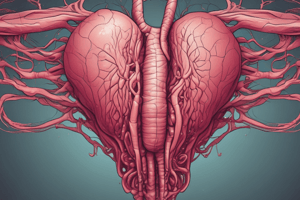Podcast
Questions and Answers
The umbilical vein carries deoxygenated blood from the foetus to the placenta.
The umbilical vein carries deoxygenated blood from the foetus to the placenta.
False (B)
Amino acid, glucose, and minerals cross the placenta to the mother.
Amino acid, glucose, and minerals cross the placenta to the mother.
False (B)
The placenta produces hormones such as insulin and thyroxine.
The placenta produces hormones such as insulin and thyroxine.
False (B)
The placenta eliminates oxygen from the foetus to maternal circulation.
The placenta eliminates oxygen from the foetus to maternal circulation.
Nutrient transport across the placenta occurs through only diffusion.
Nutrient transport across the placenta occurs through only diffusion.
The placenta stores glycogen for the mother.
The placenta stores glycogen for the mother.
The maternal surface of the placenta is also known as the chorionic plate.
The maternal surface of the placenta is also known as the chorionic plate.
The placenta is responsible for respiration in the foetus.
The placenta is responsible for respiration in the foetus.
The placenta produces human chorionic gonadotrophin (hCG) hormone only in the first trimester.
The placenta produces human chorionic gonadotrophin (hCG) hormone only in the first trimester.
The cotyledons on the maternal surface of the placenta are separated by sulci or furrows.
The cotyledons on the maternal surface of the placenta are separated by sulci or furrows.
The fetal surface of the placenta is dark red in color.
The fetal surface of the placenta is dark red in color.
The amnion is a rough and opaque membrane.
The amnion is a rough and opaque membrane.
The chorion is loosely attached to the uterine wall.
The chorion is loosely attached to the uterine wall.
The amnion aids the uterus in the initiation of labour by reducing progesterone level.
The amnion aids the uterus in the initiation of labour by reducing progesterone level.
The placenta is divided into 18-20 lobes or cotyledons.
The placenta is divided into 18-20 lobes or cotyledons.
The umbilical cord is usually inserted at the edge of the placenta.
The umbilical cord is usually inserted at the edge of the placenta.
The umbilical cord contains two veins and one artery.
The umbilical cord contains two veins and one artery.
The umbilical vein carries deoxygenated blood from the foetus to the placenta.
The umbilical vein carries deoxygenated blood from the foetus to the placenta.
The umbilical cord is usually around 20cm in length.
The umbilical cord is usually around 20cm in length.
The amnion covers the umbilical cord and the placenta.
The amnion covers the umbilical cord and the placenta.
Cutting the umbilical cord at birth causes pain to the baby.
Cutting the umbilical cord at birth causes pain to the baby.
A true knot of the cord is associated with a short cord and decreased amniotic fluid.
A true knot of the cord is associated with a short cord and decreased amniotic fluid.
Rubella and HIV can cross the placenta barrier.
Rubella and HIV can cross the placenta barrier.
Alcohol and chemicals from cigarette smoking cannot cross the placenta.
Alcohol and chemicals from cigarette smoking cannot cross the placenta.
A placenta succenturiate is a small extra lobe of placenta situated in the umbilical cord.
A placenta succenturiate is a small extra lobe of placenta situated in the umbilical cord.
Foetal hypoxia can result from a placenta succenturiate.
Foetal hypoxia can result from a placenta succenturiate.
A placenta circumvallate is a placenta that is partially divided into two lobes.
A placenta circumvallate is a placenta that is partially divided into two lobes.
A placenta bipartita is a placenta that is partially divided into two lobes with two cords.
A placenta bipartita is a placenta that is partially divided into two lobes with two cords.
A placenta fenestrata is a placenta with a missing lobe.
A placenta fenestrata is a placenta with a missing lobe.
Placenta accreta is an anatomical abnormality of the placenta.
Placenta accreta is an anatomical abnormality of the placenta.
Infarcts are a type of anatomical abnormality of the placenta.
Infarcts are a type of anatomical abnormality of the placenta.
Velamentous insertion of the cord is an anatomical abnormality of the placenta.
Velamentous insertion of the cord is an anatomical abnormality of the placenta.
Placenta Infarcts occur due to poor perfusion of the fetoplacental unit.
Placenta Infarcts occur due to poor perfusion of the fetoplacental unit.
Placenta Acreta occurs when the placenta fails to adhere to the uterine wall.
Placenta Acreta occurs when the placenta fails to adhere to the uterine wall.
Hydatidiform mole is a benign growth.
Hydatidiform mole is a benign growth.
Oedema of the placenta is associated with haemolytic disease of the newborn.
Oedema of the placenta is associated with haemolytic disease of the newborn.
Calcareous degeneration of the placenta is associated with syphilis.
Calcareous degeneration of the placenta is associated with syphilis.
Syphilitic placenta is pale and greasy looking.
Syphilitic placenta is pale and greasy looking.
Flashcards are hidden until you start studying
Study Notes
The Placenta
- Also known as the basal plate, attached next to the uterine wall, dark/dull red in color
- Mapped out into slightly elevated regions of about 18-20 lobes or cotyledon
- Cotyledons are separated by sulci/furrows and are made up of lobules with each containing a single villus with its branches
- Surface may be rough due to deposits of lime salt or calcium, especially at term
The Fetal Surface
- Also known as chorionic plate, faces the fetus in utero, bluish-gray in color
- Covered by the amnion, making it appear smooth and shiny
- Umbilical cord is usually inserted in the center with branches of umbilical vein and arteries radiating through it
The Membranes
- Two membranes: the amnion and the chorion
- Amnion: develops from the inner cell mass, tough, smooth, transparent, and shiny membrane
- Amnion covers the fetal surface of the placenta, continuous with the covering of the umbilical cord, and forms the amniotic sac containing amniotic fluids
- Chorion: develops from the trophoblast, rough, thick, fibrous, opaque, and friable
- Chorion is loosely attached to the uterine wall and continues with the edge of the placenta, aiding the uterus in initiating labor by reducing progesterone levels and increasing production of prostaglandins and oxytocin
Functions of the Placenta
Respiration
- Two umbilical arteries carry deoxygenated blood from the fetus to the placenta to be oxygenated by diffusion
- Oxygenated blood is carried by the umbilical vein to the fetus
Nutrition
- Amino acids, glucose, minerals (calcium, phosphorus, iron), vitamins, blood, and nerve cells cross the placenta to the fetus
- Nutrient transport is achieved through diffusion, osmosis, active transport, and endocytosis
Excretion
- Carbon dioxide, urea, uric acid, and bilirubin are eliminated from the fetus to maternal circulation
Storage
- The placenta metabolizes glucose, stores it in the form of glycogen for the fetus, and reconverts it to glucose and glycogen as needed
Endocrine
- Several hormones are produced by the placenta to aid in the advancement of pregnancy and the growth of the fetus
- Hormones produced by the placenta include hCG, hPL, progesterone, estrogen, and relaxin
The Umbilical Cord (Funis)
- Extends from the fetal umbilicus to the fetal surface of the placenta
- Length: about 50cm, considered short when it measures less than 40cm, diameter: about 1-2cm
- Contains one vein and two arteries surrounded and protected by jelly-like substance called Wharton's jelly
- Covered by the amnion, which is continuous with that of the covering of the placenta
Abnormalities of the Umbilical Cord (Funis)
- True Knot of the Cord: associated with long cord and increased amniotic fluid, may compromise circulation
- Velamentous Insertion of the Cord: abnormal insertion of the cord into the placenta
Abnormalities of the Placenta
Anatomical Abnormalities
- Placenta Succenturiate: a small extra lobe of placenta situated in the membranes and blood vessels connecting it to the main placenta
- Placenta Circumvallate: an opaque ring seen on the fetal surface, formed by a double layer of chorion and amnion that has undergone infraction
- Placenta Bipartita: the placenta is partly or wholly divided into two lobes, but there is only one cord
- Placenta Fenestrata: a hole in the placenta
Pathological Abnormalities
- Placenta Infarcts: suggest poor perfusion of the fetoplacental unit, where some areas in the placenta, such as the chorionic villi, die
- Placenta Accreta: the placenta adheres firmly to the uterine wall, failing to separate at the end of labor, and may require hysterectomy
- Hydatidiform Mole: a cystic degeneration of the chorionic villi, usually resulting in the fetus failing to develop
- Oedema of the Placenta: a large, pale, water-logged placenta associated with haemolytic disease of the newborn
- Calcareous Degeneration: deposit of calcium or lime salt in the placenta, believed to be associated with aging of the placenta
Studying That Suits You
Use AI to generate personalized quizzes and flashcards to suit your learning preferences.





